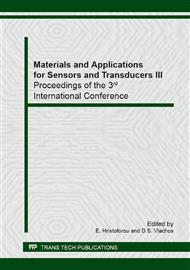p.11
p.15
p.19
p.23
p.27
p.31
p.35
p.39
p.43
Dislocation Density Effect on Thermal Diffusivity of AISI 316 Steel
Abstract:
AISI 316 steel samples have been investigated by infrared thermography (IRT) after introducing controlled degrees of plastic deformation by means of tensile tests. Microstructural examinations of the same samples showed that the progressive decrease of thermal diffusivity observed for successive steps of plastic deformation is due to the increase of dislocation density. Dislocations affect thermal diffusivity in two ways, by acting as centres of scattering and by inducing elastic stress fields. To evaluate the two contributions, IRT measurements have been also carried out in-situ, during tensile tests at progressively increasing strain. For relevant plastic deformation, the dislocations mainly affect the thermal diffusivity by scattering mechanism. On the basis of these results, it can be concluded that thermal diffusivity is significantly affected by the increase of dislocations density therefore locally resolved IRT measurements seem promising to detect states of local plasticization in mechanical components.
Info:
Periodical:
Pages:
27-30
Citation:
Online since:
April 2014
Price:
Сopyright:
© 2014 Trans Tech Publications Ltd. All Rights Reserved
Share:
Citation:


